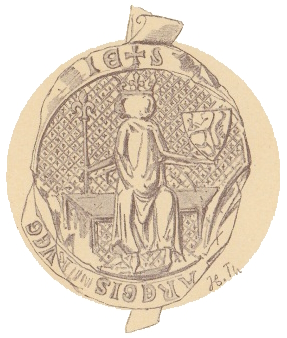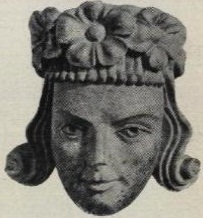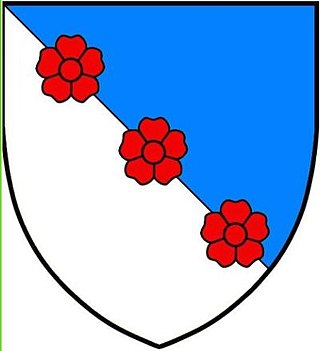

The Sudreim claim was an entitlement to the throne of the Kingdom of Norway held among members of the powerful and influential House of Sudreim in the late Middle Ages.


The Sudreim claim was an entitlement to the throne of the Kingdom of Norway held among members of the powerful and influential House of Sudreim in the late Middle Ages.
In the early 14th century, when it was foreseeable that the male line of Sverre dynasty would go extinct, members of the Norwegian nobility arranged the Order of succession of the kingdom together with the then-king Haakon V of Norway. King Haakon's youngest daughter, Ingeborg Haakonsdatter instead of her older, illegitimate half-sister Agnes Haakonsdatter received recognized rights of succession for her descendants. This entitlement came to be referred to as the Stovreim claim (Stovreimsætten). [2]
In the eventuality of Ingeborg's line dying out, it was determined that the issue and line of King Haakon's oldest daughter, Agnes Haakonsdatter, born to her in marriage to Havtore Jonsson (c. 1275–1319), would then be entitled to succession to the throne of Norway. This entitlement is referred to as the Sudreim claim (Sudreimsætten). [3]
Ingeborg's descendants brought the kingship to union with Sweden, Denmark, and with a variety of Northern German principalities. Norway's kings from her lineage regularly resided elsewhere than in Norway. Nationalistic or separatist forces in Norway sometimes pursued having a native Norwegian king who was not to become any other country's ruler—and the descendants of Agnes Haakonsdatter lived in Norway. Accordingly, their ancient right to inherit the throne was claimed and sometimes was acted upon. Periodically a monarch died without any direct heirs as did Eric II of Norway in 1299, Olav IV of Norway in 1387 and Christopher of Bavaria in 1448. In each case, a near relative had to be found to become the successor. In certain cases some native-minded Norwegians offered the throne to a Sudreim descendant, but always unsuccessfully. [4]
In the mid-14th century, Jon Havtoreson, (1312–1397) and Sigurd Havtoreson (1315–1392), sons of Agnes Haakonsdatter and Havtore Jonsson (referred to as Havtoresønnene), seem to have intrigued against their cousin Magnus VII of Norway (simultaneously King of Sweden), to take Norway from him.[ citation needed ] Haakon Jonson, son of Jon Havtoreson, is recorded as having been offered the throne in 1387–88, when Olav IV had died. Olav's mother, Queen Margaret I of Denmark, saved the situation for herself by taking a child, Bogislav of Pomerania (later renamed Eric, becoming Eric III, Eric XIII and Eric VII of countries of the Kalmar Union) to a session of the Norwegian council and presenting him as legitimate heir. Eric was a maternal great-grandson of Eufemia, daughter of Ingeborg Haakonsdatter and Duke Eric Magnusson. Eric was also the grandson of Queen Margaret's elder sister, Ingeborg, Duchess of Mecklenburg—and thus descended from recent kings of all three countries. [5]
In 1448, when Christopher of Bavaria died, the Norwegian throne was offered to Sigurd Jonsson of Sudreim, who was a grandson and ultimately the heir of Sigurd Havtoresonn and his wife Ingebjorg Erlingsdottir of Bjarkoy—but he declined because legally King Eric was still the lawful king. Sigurd held combined hereditary rights of both Ingeborg Haakonsdatter's Stovreim line and Agnes Håkonsdatter's Sudreim line. The 1448 offer to the intended "Sigurd III" was made by more or less the same party who after his refusal, worked toward having Karl Knutsson from Sweden as Norway's king instead of Christian I of Denmark ignoring that King Eric was still the only lawful king of Norway although in exile.
The succession right was not unlimited in time, but seems to have ceased by the end of the 15th century.

Haakon VI, also known as Håkan Magnusson, was King of Norway from 1343 until his death and King of Sweden between 1362 and 1364. He is sometimes known as Haakon Magnusson the Younger to distinguish him from his great-grandfather, Haakon V.

Haakon V Magnusson was King of Norway from 1299 until 1319.

Birger was King of Sweden from 1290 to 1318. His reign was marked by unrest and civil strife; he was imprisoned by his brothers Erik and Valdemar following the "Håtuna games" in 1306, but when he tried to play them the same trick in Nyköping, there was an uprising that ended with Birger losing the crown and the execution of his 18-year-old son Magnus.
The Norwegian Law of Succession was first introduced in 1163 during the Civil war era in Norway.
The Kingdom of Norway as a unified realm dates to the reign of King Harald I Fairhair in the 9th century. His efforts in unifying the petty kingdoms of Norway resulted in the first known Norwegian central government. The country, however, soon fragmented and was collected into one entity in the first half of the 11th century, and Norway has retained a monarchy since that time. Traditionally, it has been viewed as being ruled by the Fairhair dynasty, though modern scholars question whether the eleventh century kings and their successors were truly descendants of Harald.
Erling Ormsson, known as Erling Skakke, was a Norwegian Jarl during the 12th century. He was the father of Magnus V, who reigned as King of Norway from 1161 to 1184.

Eric Magnusson was a Swedish prince, Duke of Svealand, Södermanland, Dalsland, Västergötland, Värmland and North Halland and heir to the throne of Sweden. His son, Magnus, became king of Norway and Sweden.

Olav Nilsson Skanke was a Norwegian nobleman, knight and privateer. He was a member of the Riksråd and served as commander of Bergenhus Fortress.
Olav Ugjæva or Olav Gudbrandsson was a pretender to the Norwegian throne during the civil war era in Norway. Olaf was named king in 1166, but was subsequently defeated by King Magnus V of Norway and forced to flee the country.
Erling Vidkunsson (1293–1355) was the Norwegian nobleman and regent of Norway. He received the position of High Justiciar (drottsete) of the country. He was Lord of Bjarkoy and Giske and was probably the most important and wealthy Norwegian noble of his era.

Sigurd Jonsson was a Norwegian nobleman, knight and the supreme leader of Norway during two interregnums in the mid-15th century.

Henrich Krummedige, was born circa 1464 in Norway and died in 1530. He was a Danish-Norwegian nobleman and a member of both the Norwegian and Danish National Councils (Rigsråd) and played an extensive role in the politics of the era. He served as commanding officer of the Bohus Fortress in Norway from 1489 to 1503.

Alv Knutsson was a Norwegian nobleman who descended on his father's side from the influential and wealthy Swedish Tre Rosor noble family. He was a member of the Norwegian council of the realm and also served as commander of the royal castle in Bergen. Alv Knutsson is most famous for his involvement in the Krummedige-Tre Rosor feud. He was the father of the Norwegian rebel leader Knut Alvsson.

The Roos af Hjelmsäter family is a Swedish noble family of Norwegian noble and royal origin. It is among the few of Norway's medieval noble families still living.
Princess Agnes Haakonsdatter of Norway was the oldest daughter of King Haakon V of Norway by Gro Sigurdsdatter, daughter of Sigurd Lodinsson and wife Baugeid Steinarsdatter and as such the prime heir.
Events in the year 1319 in Norway.
Herdis Torvaldsdatter was a Norwegian noblewoman and landowner.
Ragnhild Skoftesdotter was a Norwegian noblewoman and landowner.
Jon Havtoresson was the son of knight Havtore Jonsson and princess Agnes Håkonsdatter, illegitimate daughter of King Håkon V Magnusson.